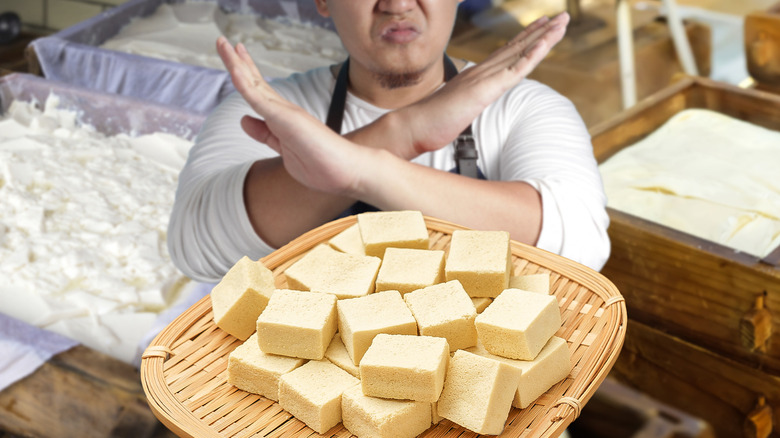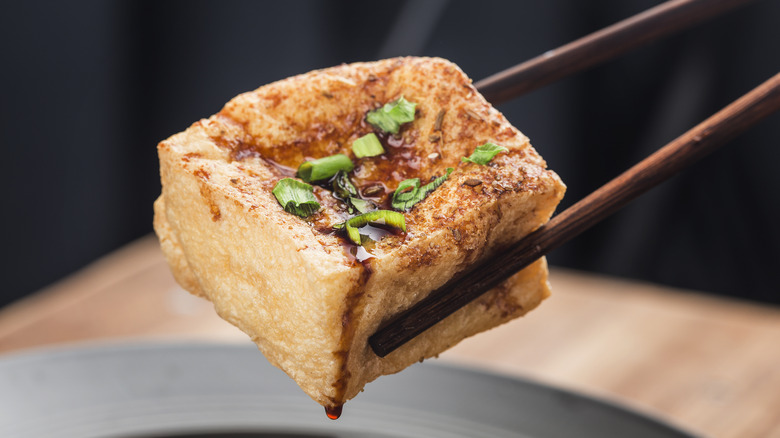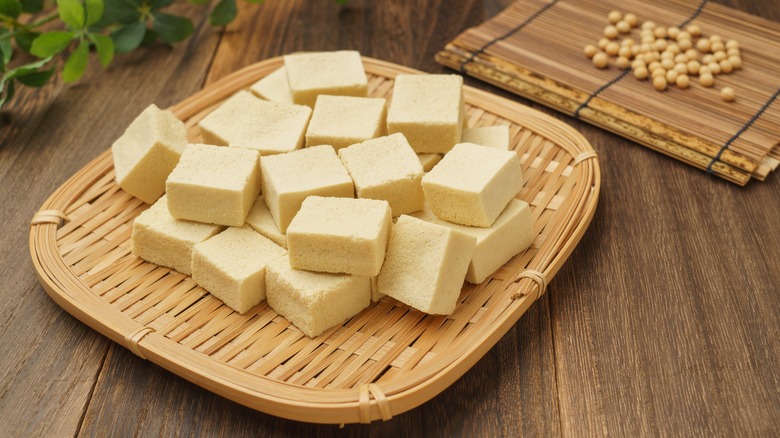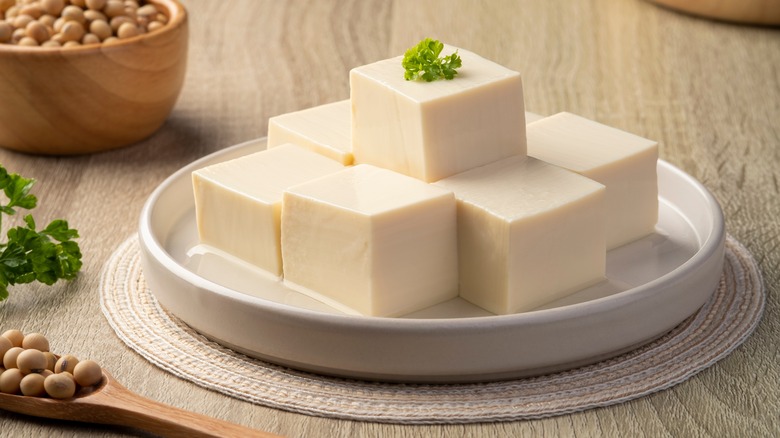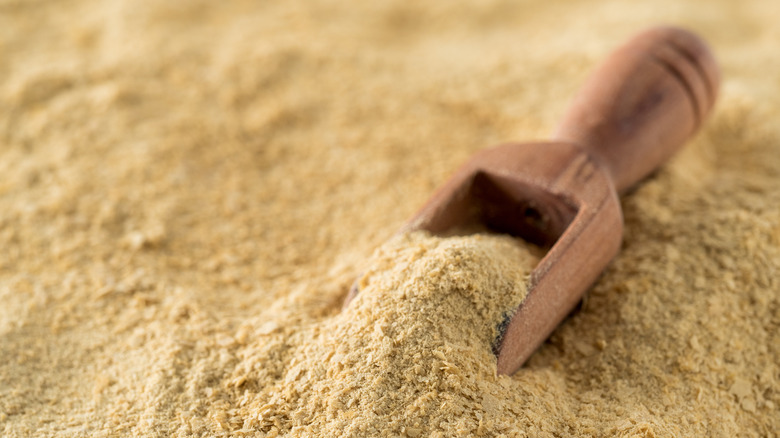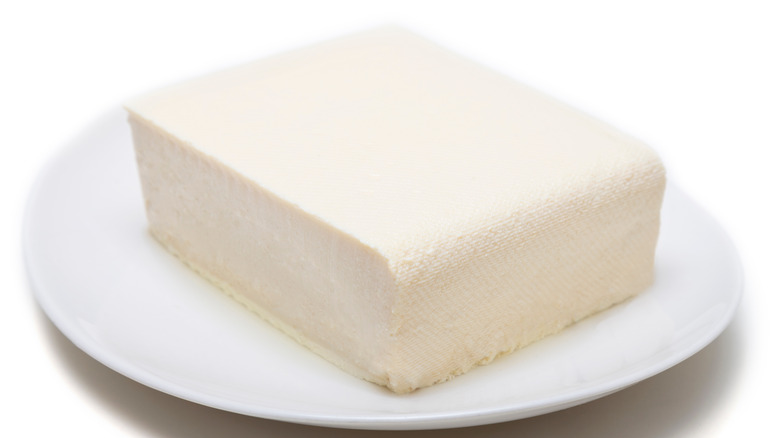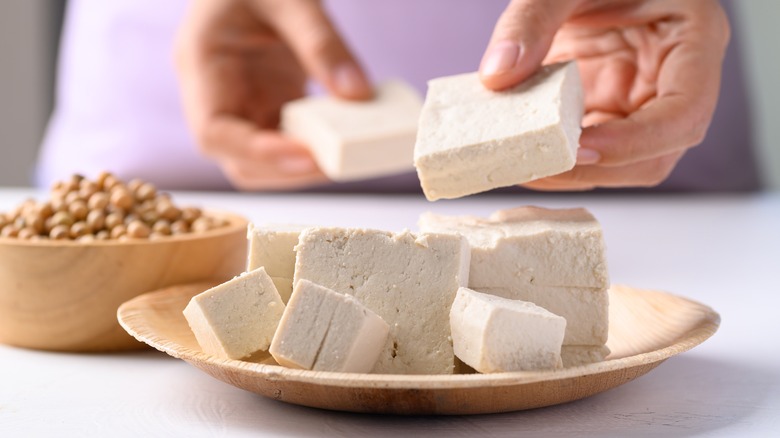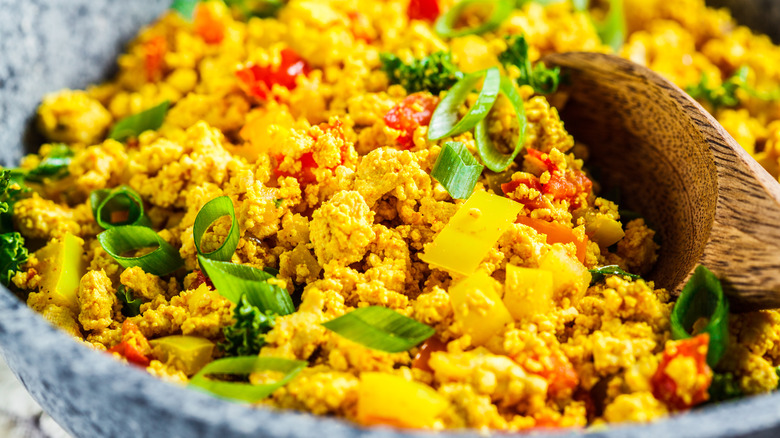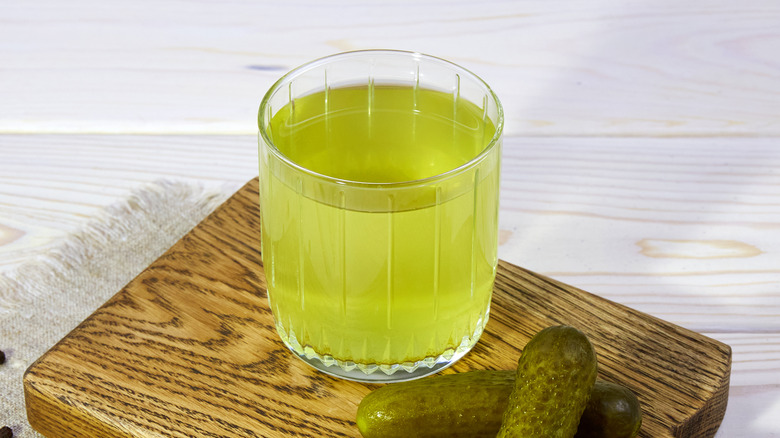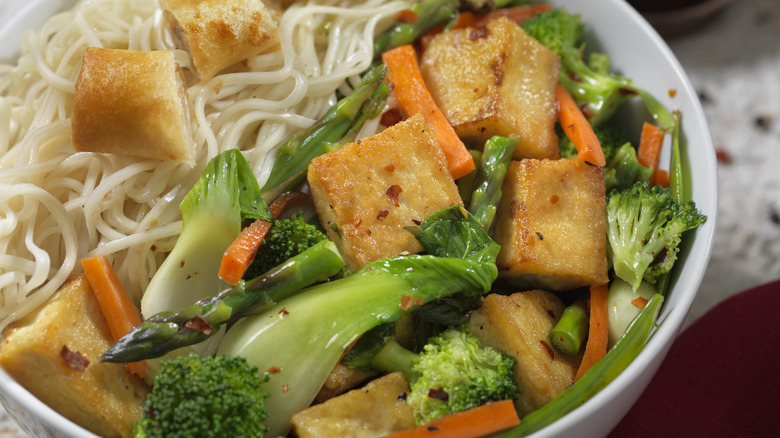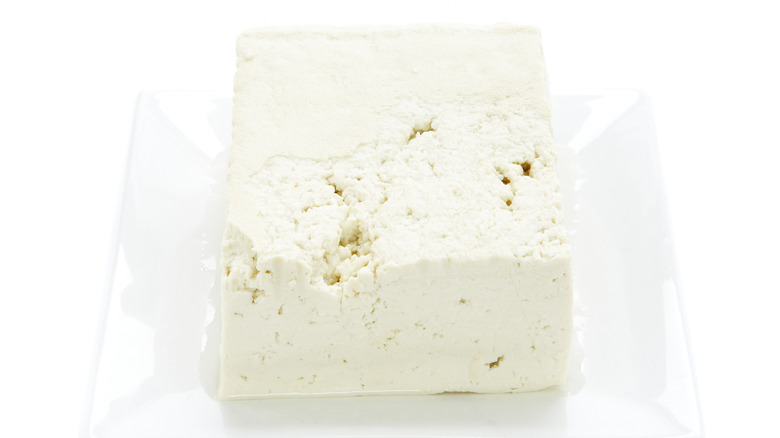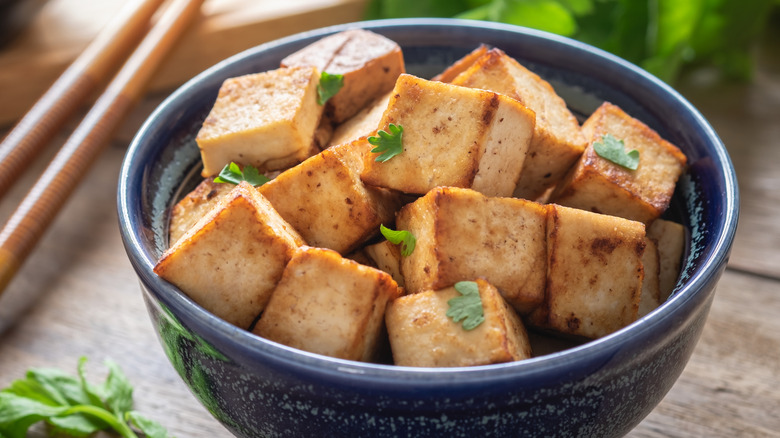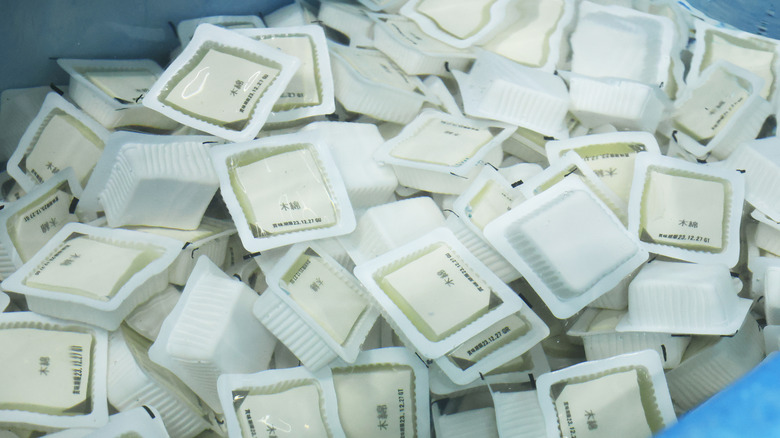14 Mistakes Everyone Makes When Cooking Tofu
Tofu may just be one of the most misunderstood and unfairly maligned foods, at least in the U.S. It's been associated as bland, flavorless, and mostly showing up in vegan dishes even though it has a rich history of appearing in recipes with and without meat in various cultures, especially in East Asia, for much longer than it's been popular in the United States. Too many people only try cooking tofu once without really understanding how to make it, and when it comes out tasting watery and spongy, they decide that tofu simply doesn't taste good.
But if you ask us, that's not true at all. Eat some well-cooked tofu, and you'll understand why so many include it in their diets on a regular basis. And why shouldn't we be more frequently eating this protein that the American Heart Association advises is nutritious?
Give tofu another chance. If your tofu always comes out wrong, see if you're making any of these 14 mistakes with the ingredient. Once you find what you're doing incorrectly, your next batch of tofu dishes might come out right.
1. Not seasoning your tofu
The cardinal sin of cooking tofu? Not seasoning it, or not seasoning it enough. Would you throw a steak on the grill without giving it a very generous sprinkling of salt and pepper? Of course not. Would you place bare pork chops straight onto a pan without marinating them first? Only if you wanted pretty tasteless meat on your plate. So then, why would you assume that you can treat tofu any differently? The truth is that seasoning your tofu properly is probably the most important step you can take in the cooking process.
Tofu doesn't have a lot of flavor on its own, so you need to infuse it with flavor from other ingredients. You could make an oil-based marinade if you plan on air frying your tofu, or you could use dry seasonings if you're going to roast your tofu. Don't be afraid to play around with different flavor combinations, and remember to use those seasonings liberally — that's what you're going to taste when you take that first bite of tofu.
2. Choosing the wrong tofu for the recipe you're making
If you're new to cooking tofu, you may think picking up any pack of tofu from the grocery store for your recipe is fine. However, since most stores carry a wide variety of tofu, that probably won't turn out well for you. Therefore, you should understand the differences between the different kinds of tofu.
When you want to make crispy tofu, you'll want to opt for the firm or super firm sorts. This kind of tofu can hold up well under high heat and won't fall apart as soon as you place it in a pan. On the other hand, some recipes will call for silken tofu, which has — as the name suggests — a smooth, silky texture. This variety of tofu will generally not work well in roasted or fried tofu dishes, so make sure you consult your recipe before deciding which type to buy.
3. Only thinking about tofu as a meat substitute
Some of us were first exposed to tofu in the context of a meat replacement, and that shadows our perception of the ingredient. But tofu is so much more than a vegetarian-friendly meat stand-in. It has its own identity and deserves to shine in its own right. First, you may want to look up some tofu recipes to get a better idea of how the ingredient is used in a multitude of dishes. Notice that in some of these dishes, tofu is the only protein you'll find, while in others, tofu appears alongside eggs or meat.
Once you've familiarized yourself with how different cooks use tofu, you can give it a try yourself. If you're worried tofu alone won't be filling enough, consider making it in a dish that also includes meat. For example, mapo tofu is a staple Chinese dish featuring braised tofu pieces and ground pork. Another classic is Korean soondubu jjigae — this tofu stew can be ladened with meat or seafood with the option to adjust the spiciness level. Once you see how many ways tofu can be cooked and included in different dishes, you may be more inclined to incorporate it into your diet regularly.
4. Not using enough salt
When it comes to neutral-tasting ingredients like potatoes, pasta, and, yes, tofu, salt is an extremely important ingredient. Have you ever wondered why tofu at restaurants tastes so much better than what you make at home? It largely comes down to salt content, and you're almost certainly not using enough salt. We get it — you want to make sure you're not ingesting too much sodium in your diet. But if you want your tofu to taste as good as it can, it's important to season it with plenty of salt, as it's a determining factor in your tofu dish's overall deliciousness.
You can use salt to your full advantage even before you turn on the stove. Once you drain the water from the tofu container, sprinkle salt generously over the tofu to remove the remaining moisture. Then, put it in the fridge for several hours and scrape off all the salt before you cook it. The result is a well-seasoned block of tofu with wonderful texture. When you're ready to cook it, remember to add salt or salty sauces like soy sauce or teriyaki sauce whenever you add another ingredient to the pan. Doing so will add more depth and flavor to the dish. However, taste your food frequently during the cooking process to know when to add more salt. Start taking salt seriously, and you'll be blown away at how amazing your tofu will taste.
5. Forgetting to use nutritional yeast
In the world of vegetarian food, some ingredients are more prominent than others. Tofu is one of those foods, of course, but it's not the only one. Another ingredient you'll see included in many vegetarian recipes is nutritional yeast. Nutritional yeast looks like little yellow flakes and has a distinct savory, almost cheesy flavor. Because it packs such an intense flavor, it's a favorite for seasoning tofu — especially when paired with other savory spices, like paprika and chili powder.
Using nutritional yeast when making crunchy tofu contributes to that crispness you're going for. Make sure to sprinkle a generous amount of nutritional yeast onto your tofu before putting it into the oven or air fryer. You'll get crisp, brown, and savory tofu cubes in no time at all. If you want even more of that cheesy flavor, you can sprinkle some more nutritional yeast on your tofu after it's done cooking.
6. Not pressing your tofu before cooking it
If you've ever worked with firm or super firm tofu before, you know that it comes in a package filled with water. Before you cook your tofu, you have to drain that water out. But that's not all it takes to cook tofu correctly. You're going to need to make sure that you get as much water out of the tofu as possible, as any extra moisture left behind can dilute the flavor of the dish and can make your tofu soft and soggy when what you're going for is a crispy, dryer texture.
The best way to ensure your tofu is as dry as possible before dropping it in a pan is to press it before cutting or cooking. Wrap the block of tofu in a towel, then place something heavy on top of it. You'll want to leave the tofu like that for about an hour so all the moisture comes out and seeps into the towel.
Yes, pressing your tofu is an extra step that can slow the cooking process, but it's worth the time and energy. Once you bite into that cube of perfectly textured tofu, you'll get why it was so important to press it.
7. Over-pressing your tofu before cooking it
Pressing your tofu is important for some recipes, of course, but that doesn't mean you'll want to treat every type of tofu the same way for all dishes. For example, when it comes to silken tofu, pressing simply isn't going to work — the tofu is too soft, and it'll fall apart immediately. Plus, for most recipes that call for silken tofu, it's not necessary to get the tofu as dry as possible.
The same goes for scrambled tofu; you should only press the tofu for about 15 to 30 minutes at most. Why? Since you're trying to mimic the soft texture and appearance of the eggs, you'll want some moisture left in the tofu. Also, this prevents the pan from drying out too much. Think about what kind of texture you're going for in each recipe, then treat your tofu accordingly for the best results.
8. Cutting your tofu instead of tearing it
We're all trying to achieve that pan of marvelously crispy tofu, but it can be hard to do if the conditions aren't absolutely perfect. While pressing your tofu for a considerable amount of time is important, there are other steps you can take to make your tofu as crunchy as possible. One easy way to establish more crisped tofu pieces in every bite? Tear your tofu instead of cutting it.
It might feel strange to rip apart a block of tofu instead of just cutting it with a knife like you usually do, but hear us out. When you cut tofu, it creates flat, straight sides. Those flat sides can get crispy, sure, but they won't fry up as easily as a piece of tofu that has a lot of jagged edges. Tearing tofu ensures it has a ton of nooks and crannies that can get incredibly crispy as the tofu cooks, so it's an easy way to give your tofu a simple upgrade without a ton of extra work.
9. Forgetting to brine your tofu
Most people think tofu and meat are very different things, but in reality, you can treat them much the same way. For example, if you want to make your chicken super flavorful, what can you do before you cook it? You may choose to use a brine, a salt-based liquid that'll boost the flavor of your chicken before you even start cooking it. Well, you can do the same thing with tofu. In fact, brining your tofu may just be the best way to make it taste delicious.
If you want to keep things simple, you can make a brine out of salt and water. However, you don't have to stick with the basics if you want to make your tofu even more interesting. We love brining with other flavorful, salt-forward liquids, like pickle juice or water mixed with spices. Brining for 15 minutes will surely do the trick.
10. Not using super firm tofu in your stir-fry
If you're a beginner in this tofu business, stir-fry is one of the easiest dishes to start with. It comes together quickly without much fuss and is relatively difficult to mess up. However, you'll still want to choose the right kind of tofu for this dish to get the best possible results. When you're standing in front of the tofu section, wondering which variety will work best for your stir-fry, don't think too much and directly look for super firm tofu.
Why do you need to work with this kind of tofu specifically? Well, you'll probably want the tofu in your stir-fry to end up at least somewhat crispy, but when you have a bunch of vegetables and liquids in the pan, it can be hard to pull off the texture you're going for. By choosing super firm tofu, which has a lower water content than other varieties, you can still get that nice stiff shell you're going for while also letting the other ingredients cook to perfection.
11. Assuming you have to cook tofu at all
This article may be all about potential mistakes you could make while cooking tofu, but do you even have to cook it in the first place? Technically, you don't have to. That's because tofu is already cooked, so you can eat it straight out of the package. When it comes to some types of tofu, eating without cooking it is the norm. For example, if you see a recipe call for silken tofu, you may not need to cook it at all. In some parts of the world, a wide variety of dishes don't require heat on the tofu.
Now that you know you can consume tofu straight out of the package, you can incorporate it into your diet in more ways. It can be difficult to meet your daily protein requirements constantly, so having an easy, fuss-free protein source at your disposal makes meal planning that much easier.
12. Cooking crispy tofu on low heat
We all want to execute that perfectly crunchy tofu texture, but if you don't have much experience cooking the ingredient, that can be difficult. One step you can take to get your tofu as satisfyingly crispy as possible? Make sure you use high heat. Often, people new to cooking with tofu are afraid of burning the delicate-looking food, so they place their pan on medium-high heat or lower. That temperature will warm your tofu, sure, but it won't create that wonderful goldenness you're going for.
Instead, if you're trying to achieve that amazingly crunchy tofu you've had in restaurants in the past, you'll want to use very high heat when cooking the tofu. It's also just as important to make sure you don't overcrowd your pan with tofu because it will cause steam, turning the tofu soft and soggy, negating the high heat used.
13. Not changing the water in your leftover tofu
Sometimes, when you buy a block of tofu, you end up not using the entirety of it in one recipe. When that's the case, you'll want to save your leftover tofu to enjoy later. Tofu comes packed in water when you buy it from the store, so you should do your best to recreate those storage conditions at home. Place your tofu in a storage container, fill it with water, and place it in the fridge.
But wait — you're not done yet. If you're keeping your tofu in the fridge for more than a day or two, you'll want to change the water every one to two days. It keeps the tofu fresh and helps it last as long as possible. This storage method typically grants you around seven to 10 days of freshness. Yes, this requires an extra step, but it's worth it to prevent food waste.
14. Refusing to cook your tofu in an air fryer
There are so many different ways to cook tofu. If you're using your tofu in a soup like Korean sundubu jigae, you may simply boil the tofu for a few minutes before you serve it. In other cases, you might want to use an oven to roast your tofu to perfection. Perhaps you're trying to do a homemade version of that crunchy tofu dish from your favorite restaurant, and you fry the tofu slices to attain that ideal texture. You may even decide to saute your tofu on the stove.
But if there's one cooking method we especially love, it's air frying tofu. It is a great way to cook tofu because it helps get rid of all that extra moisture in your tofu, which is what makes it soggy. Therefore, it's super easy to make crispy tofu when you use an air fryer, even if you don't press your tofu well before you cook it.
